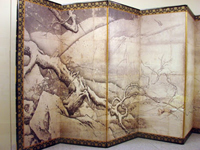Shubun
Tensho Shubun (1414 – 1463) was a Japanese painter in the Muromachi period and a Zen Buddhist monk, and - for some time - abbot at the Shokoku-ji temple in Kyoto.
He was the pupil of Josetsu and the master of Sesshu, and arguably Japan's first genuinely great landscape painter, in the early 15th Century. He was certainly seen as a huge influence and had many followers, but he was really a channel for very specific influences from China. He learned the specified brushstrokes very thoroughly, and passed the rules on to many generations of Japanese artist.



His work most closely resembles my favourite Chinese painter Xia Gui, from 200 years earlier. The painting here is a shigajiku - the full image is about three times as high, the rest taken up by calligraphy by six monks. The title gives away that it is from that most popular genre of the form, the scholar's retreat, a fantasy home in an idealised landscape. We have the stereotyped, standardised brushstrokes that he took from great Chinese Song dynasty landscape painters, but like Bonpo on the previous page, there is a sense that Shubun is more focussed on the negative space implied by the rocks than Xia Gui ever was.
A student of Josetsu, Shubun became one of the most influential painters of the suiboku style ink painting alongside with Sesshu, his pupil. Many landscape paintings in ink in varying quality and style are attributed to Shubun. Examples are in the Fujiwara collection and the Seikado Foundation. Famous is his realistic landscape painting Reading in a Bamboo Grove (1446, in the Tokyo National Museum).
He was chief painter to the shogun. In 1423 or 1424, he went on an official trip to Korea as part of the shogun's embassy.Shubun is credited in Japan, along with Seshu, as the greatest and most influential painter of the Muromachi period. The cultural roots in the Muromachi art lay in China's Southern Song dynasty, with Zen as a primary principle in art. Shubun is believed to have perfected the Japanese monochrome Zen painting.







